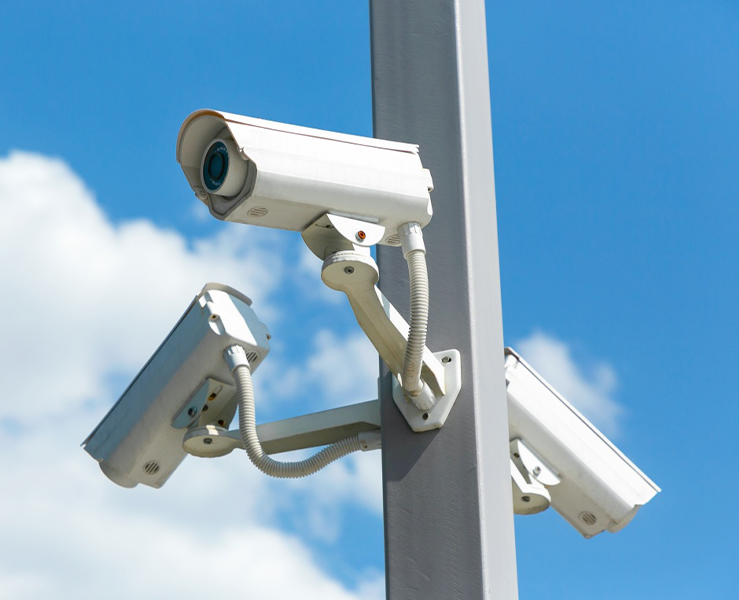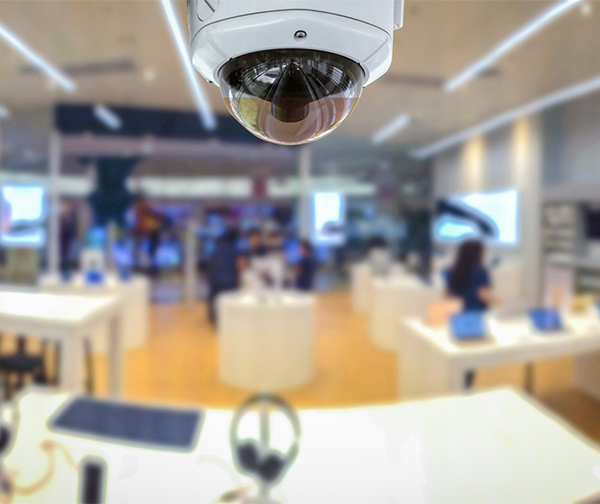Blog

March 31, 2025
Determining the right number of cameras depends on your property’s layout, security needs, and vulnerability areas. The key is not to overload your system but to cover all critical areas. For example, areas like entry points, high-traffic zones, and spots where valuables are stored should be prioritized.
Let’s break down how to find that balance and ensure your property is protected.

Security cameras are devices designed to capture and record video footage to monitor and protect your property. They come in different types, such as indoor, outdoor, wired, and wireless, each with features suited to specific security needs. These cameras provide real-time surveillance and allow for stored recordings, helping you monitor activity and investigate incidents when needed. Modern security cameras offer advanced features such as motion detection and night vision for enhanced protection.
Yes, some cameras can function without the internet. However, if you want to access live footage remotely or get smart alerts, you’ll need an internet connection. For local storage and monitoring, a CCTV system with DVR/NVR can run independently, so you can still record and review footage without being online.

Dome cameras are great for indoor use because of their discreet design. They blend well into the environment and cover a wider area, making them ideal for monitoring larger rooms or corridors. Their design also deters tampering since it’s hard to tell which direction the camera is pointing. They are a great option for indoor security.

Box cameras are known for their versatility and high-resolution capabilities. They’re customizable, offering interchangeable lenses and housings for various environments. This makes them perfect for situations requiring detailed surveillance, like facial recognition or license plate reading.

Bullet cameras are built for long-distance monitoring. They’re ideal for outdoor surveillance, especially in large areas. Many come with night vision and motion detection features, ensuring clear images even in low-light conditions. Their visible presence also acts as a deterrent for potential intruders. For large properties, they can provide maximum coverage.

PTZ cameras offer flexibility, with the ability to pan, tilt, and zoom, giving you full control over monitoring different areas. These cameras are particularly useful for both indoor and outdoor settings where real-time monitoring is essential.
Thermal and infrared cameras are crucial for low-light surveillance. They detect heat signatures instead of relying on visible light, making them perfect for outdoor monitoring at night or in cloudy conditions. These cameras are excellent for perimeter security and can trigger alerts when movement is detected.
Property Size and Layout: Larger properties generally need more cameras, while smaller ones may only require a few strategically placed units. The key is to position cameras in spots that maximize coverage. For instance, if you have a large backyard or multiple entry points, you’ll likely need more cameras than if you live in a smaller, more compact home. Your floor plan can help guide your camera placement to ensure all entry points and high-traffic areas are monitored.
Vulnerable Areas: Identify areas where security is most critical. For example, entry and exit points like front doors, back doors, and windows should always be monitored. High-traffic areas such as hallways, driveways, or parking lots also need attention. Don't forget areas like storage rooms or places where valuables are kept, as they may be targets for theft.
Level of Threat: Understand the risks specific to your area. If you live in a neighborhood with a high crime rate, you may need additional cameras. On the other hand, fewer cameras may be sufficient if you live in a relatively low-risk area. Assessing the level of threat helps you decide how extensive your surveillance system should be.
Camera Type and Technology: The type of camera you choose can impact the number you need. High-resolution cameras with a wider range can cover larger areas, reducing the number of cameras necessary. For instance, a PTZ (Pan-Tilt-Zoom) camera can cover a large area and zoom in on specific targets, allowing you to monitor multiple zones with fewer units. Additionally, outdoor cameras equipped with motion detection can help cover the outer perimeter of your property, reducing the number of cameras needed.
Budget: Your budget plays a significant role in determining how many cameras you can afford. While you want to ensure comprehensive coverage, you may need to balance the cost of more advanced cameras or additional units with your overall security budget.
Here’s how you can determine the number of cameras you need for your property for optimum security:

Measure the area you want to monitor to get a rough estimate of the number of cameras you'll need.
Use this simple formula to help you calculate:
Number of Cameras = Total Area ÷ Camera Coverage Area
For instance, let’s say you’re securing a parking lot that’s 100 feet by 50 feet. The total area is 5,000 square feet (100 x 50). If your camera has a coverage area of 1,000 square feet, the formula would be:
5,000 ÷ 1,000 = 5 Cameras
This means you'd need at least 5 cameras to cover the entire lot. However, keep in mind that some areas might require more detailed monitoring (like entrances), so adjust accordingly. You’ll also want to account for factors like camera range, resolution, and placement to avoid blind spots.
To determine how many cameras you need, start by identifying high-risk zones. These areas should be your primary focus when calculating the number of cameras required.
For example:
Entry Points: Doors and windows are common entryways for intruders. Depending on your property's entrances, you may need at least one camera per entry point. A single camera could cover multiple smaller entryways, but larger doors or gates may require separate coverage.
High-Traffic Zones: Hallways, driveways, or parking lots often experience frequent movement. If you have a large driveway or multiple hallways, you may need multiple cameras to ensure full coverage, especially at key intersections or points of access. This is where wide fields of view can come in handy to cover multiple areas with fewer cameras.
Valuable Storage Areas: Locations like offices, safes, and storage rooms where valuables are kept should have dedicated cameras. For example, one camera may be sufficient for a small office, but a larger warehouse or store may need multiple cameras positioned to cover all sensitive areas effectively.
For homeowners asking, “How many security cameras do I need for my house?” the size and layout of your property play a significant role.
Larger properties, such as multi-story homes, expansive yards, or large driveways, will require more cameras to ensure full coverage. On the other hand, smaller homes or areas may only need a few cameras. The key is to place cameras strategically to cover all critical areas and avoid leaving any blind spots.
For example, if you have a small apartment or a house with minimal outdoor space, just a couple of cameras near the front door and entryway may be sufficient. However, for larger properties, like a house with a front yard, driveway, and backyard, you’ll need cameras positioned in several key areas to ensure comprehensive surveillance. This way, you can effectively monitor all entrances, outdoor spaces, and vulnerable spots around your home.

Your property’s level of risk depends on factors like the local crime rate and the type of business or home you have. For instance, a retail store may have security concerns that are different from those of an office building. Understanding these risks will help you determine how many cameras you need and their placement.
Resolution and range are key factors when planning the number of cameras to install. Higher-resolution cameras, like 1080p or 4K, provide clear, detailed footage over a wider area. This means you can cover more ground with fewer cameras. For example, a video doorbell at the front door can provide a clear view of visitors without the need for additional cameras.
However, lower-resolution cameras, such as 720p, may not capture as much detail, particularly in low-light conditions or over long distances. As a result, you might need more cameras to cover the same area effectively.
In addition to resolution, it’s important to consider your network's capacity. So, if you ask, “How many Mbps do I need for security cameras?”
The higher the resolution and frame rate of your cameras, the more bandwidth your network will need to transmit and store footage. For instance, 4K cameras require more Mbps than 720p cameras. Make sure your network has enough bandwidth to handle the data load, which can affect how many cameras you can effectively use.
Plan for overlapping camera fields of view to ensure comprehensive coverage and prevent blind spots. This redundancy is crucial in high-traffic or high-risk zones where constant monitoring is needed, such as entrances, loading docks, or areas with valuable items. For example, if an entrance is a vulnerable point, placing two cameras at different angles ensures continuous surveillance, even if one camera fails or its view is obstructed.
By adding extra cameras to overlap in key areas, you not only reduce blind spots but also improve the quality of evidence. In the event of an incident, having multiple angles of the same scene increases the likelihood of capturing crucial details, making it easier to identify suspects and gather proof.

Protecting what’s important to you begins with choosing the right security cameras. It’s not just about the number of cameras—it’s about understanding your property’s needs and placing them in the right spots to cover every angle. With the right plan, you can feel secure knowing you’re prepared for anything.
At HSI Security, we offer custom solutions that adapt to your unique security challenges. Our expert team and top-tier technology are here to provide reliable, around-the-clock protection for your residential properties and businesses. Let us take the guesswork out of securing your property so you can rest easy and be focused on what matters most.
Ready to secure your property? Contact HSI Security today and start building your ideal security setup!
JULY 03, 2024
JULY 03, 2024
JULY 03, 2024